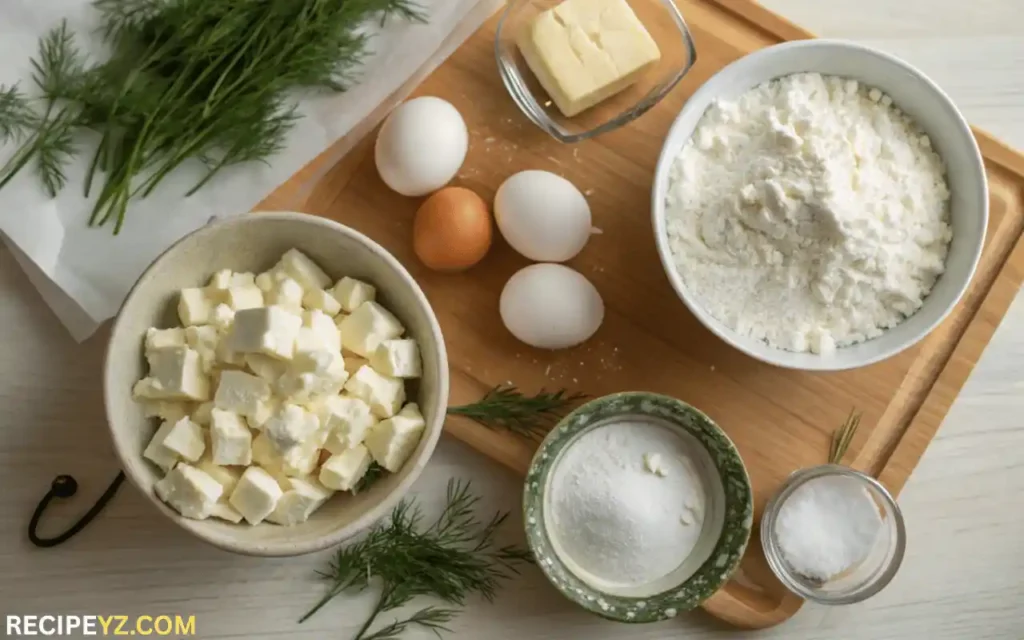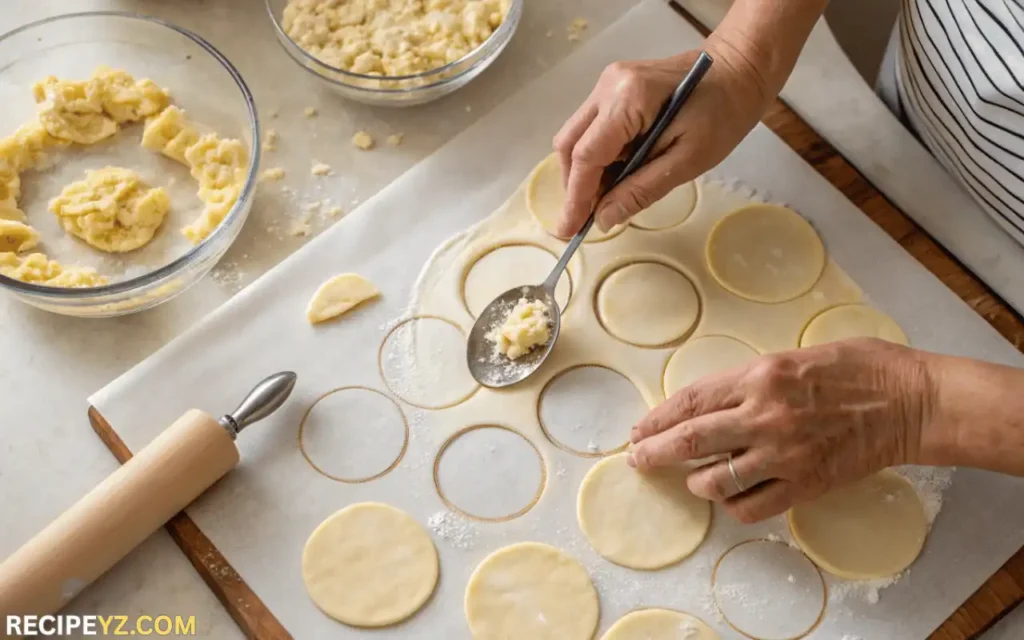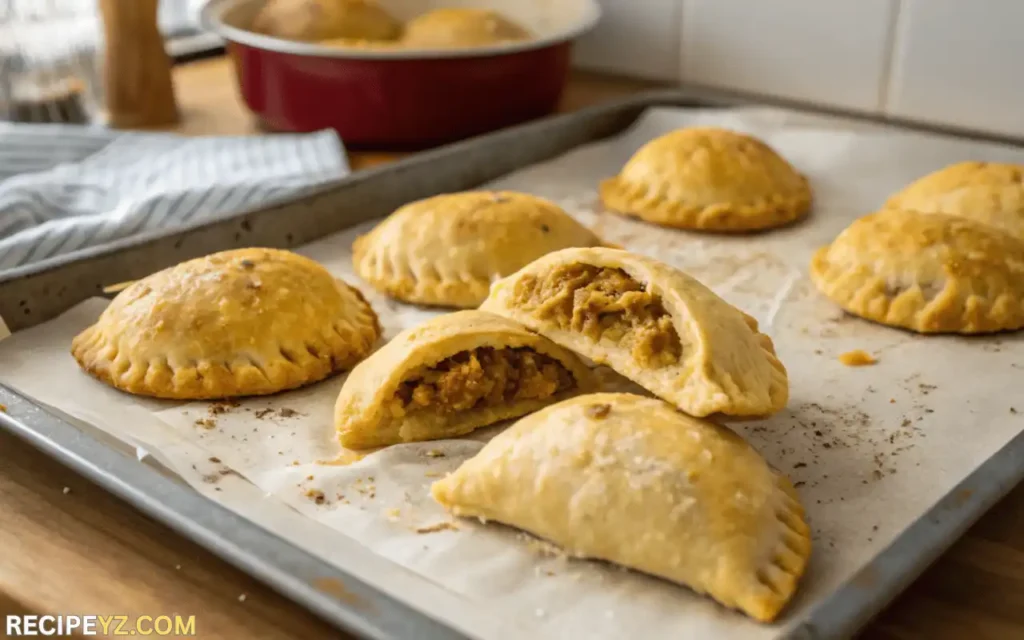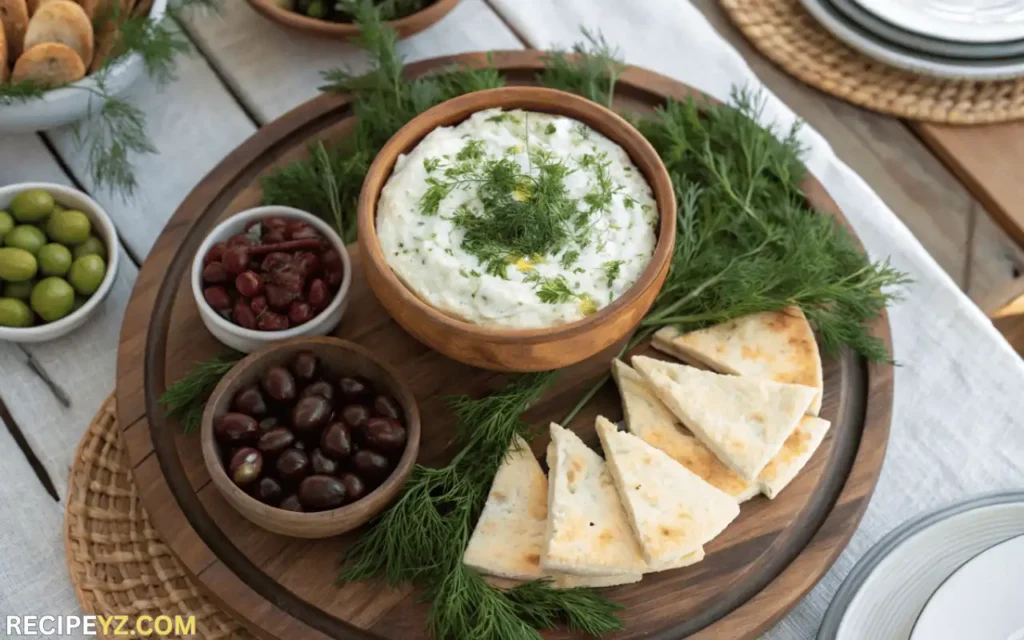Suppose you love the idea of flaky, buttery Greek pastries filled with creamy cheese. In that case, Tiropitakia Kourou will quickly become your new favourite snack.
The rich, crumbly pastry of these mini cheese pies surpasses the typical phyllo, providing a mouthwatering experience with each bite.
Perfect for everything from casual family meals to festive gatherings, Tiropitakia Kourou is an authentic taste of Greece’s culinary heritage.

Best Tiropitakia Kourou recipe
- Total Time: 55 minutes
- Yield: 20 mini pies 1x
Description
Tiropitakia Kourou are mini Greek cheese pies made with rich, buttery Kourou pastry and filled with creamy feta cheese. These bite-sized treats are perfect for sharing, embodying the spirit of Greek meze.
Ingredients
- 2 cups all-purpose flour
- 1 tsp baking powder
- 1/2 tsp salt
- 1/2 cup unsalted butter, cold and cubed
- 1/4 cup Greek yoghurt
- 1 egg
- 1/2 cup feta cheese, crumbled
- 1/4 cup ricotta or anthotyro cheese
- 1 egg (for brushing)
- Optional: fresh dill for seasoning
Instructions
- Prepare the Kourou dough: In a large bowl, sift together flour, baking powder, and salt. Add cold, cubed butter and rub it into the flour until it resembles coarse crumbs. Mix in Greek yoghurt and egg until the dough starts to come together. Lightly knead on a floured surface until smooth. Wrap in plastic and refrigerate for 30 minutes.
- Make the cheese filling: Combine crumbled feta and ricotta or anthotyro with an egg. Season with pepper and optional fresh dill.
- Shape the Tiropitakia: Preheat oven to 180°C (350°F). Roll dough to 0.5 cm thickness and cut into 8 cm circles. Place a spoonful of cheese filling on each circle. Fold dough over to form a half-moon and press edges with a fork. Brush tops with beaten egg.
- Bake: Place pies on a parchment-lined baking sheet and bake for 20–25 minutes, or until golden and crisp.
- Cool slightly before serving.
Notes
Tiropitakia Kourou can be frozen both before and after baking. For best results, bake directly from frozen without thawing.
- Prep Time: 30 minutes
- Cook Time: 25 minutes
- Category: Appetizer
- Method: Baked
- Cuisine: Greek
Nutrition
- Serving Size: 1 mini pie
- Calories: 200
- Sugar: 1g
- Sodium: 150mg
- Fat: 14g
- Saturated Fat: 7g
- Unsaturated Fat: 6g
- Trans Fat: 0g
- Carbohydrates: 20g
- Fiber: 1g
- Protein: 5g
- Cholesterol: 40mg
Table of Contents
Origins & Cultural Significance in Greek Cuisine
Tiropitakia Kourou has deep roots in Greek culinary tradition, where food is not just sustenance but a celebration of culture and community.
These mini cheese pies are often found on the tables of family gatherings, religious holidays, and festive occasions.
Unlike other Greek pastries that use thin phyllo dough, tropicalia Kourou is made with a rich, buttery kourou dough—similar to shortcrust pastry—giving it a unique texture and flavour.
Historically, the use of simple, local ingredients like feta cheese and yoghurt in the dough reflects the Greek emphasis on fresh, high-quality produce.
Over generations, tropicalia has become synonymous with hospitality, symbolizing warmth and generosity in Greek homes.
Their bite-sized form makes them perfect for sharing, embodying the spirit of Greek meze—small dishes meant to be enjoyed together with friends and family.
Essential Ingredients & Authentic Kourou Dough Recipe
The magic of Tiropitakia Kourou starts with the ingredients, especially the dough. Authentic Kourou dough sets these pies apart from other Greek pastries, offering a tender, crumbly texture that melts in your mouth.

Key Ingredients:
- All-purpose flour serves as the base of the dough, providing structure and stability.
- Unsalted butter: Cold and cubed, butter adds richness and flakiness.
- Greek yoghurt: Adds moisture and a slight tang, softening the dough.
- Egg: Helps bind the dough and adds richness.
- Baking powder: Lightens the dough, contributing to its tender crumb.
- Salt: Enhances overall flavour.
Using high-quality butter and Greek yoghurt—preferably made from sheep’s or goat’s milk—will elevate the authenticity and flavour. The cheese filling is traditionally feta, sometimes combined with softer cheeses like ricotta or Anthony to create a creamy texture.
For a detailed guide on making the dough and filling, check out our Complete Tiropitakia Kourou Recipe Guide and How to Make Authentic Tiropitakia Kourou with Homemade Kourou Pastry.
Why Kourou Dough?
Unlike phyllo, which is thin and crispy, Kourou dough is thicker and crumbly, similar to a shortcrust pastry. It requires minimal rolling and handling, making it easier for home cooks while delivering a rich, buttery taste.
Step-by-Step Classic Tiropitakia Kourou Recipe
Making Tiropitakia Kourou from scratch might seem intimidating. Still, with this straightforward, step-by-step approach, you’ll master the process in no time.

1. Prepare the Kourou dough.
- In a large bowl, sift together flour, baking powder, and salt.
- Add cold, cubed butter and rub it into the flour until it resembles coarse crumbs.
- Mix in Greek yoghurt and egg until the dough starts to come together.
- Lightly knead the dough on a floured surface until smooth.
- Wrap in plastic wrap and refrigerate for at least 30 minutes.
2. Make the Cheese filling.
- Crumble feta cheese and combine it with ricotta or anthotyro if using.
- Add an egg to bind the filling and season with a pinch of pepper, along with optional fresh dill.
3. Shape the Tiropitakia

- Preheat oven to 180°C (350°F).
- Roll out the dough to a thickness of about 0.5 cm.
- Cut into circles (approximately 8 cm in diameter) using a cookie cutter or a glass.
- Place a spoonful of cheese filling in the centre of each circle.
- Fold dough over to form a half-moon and seal edges by pressing with a fork.
- Brush the tops with a beaten egg for a golden finish.
4. Bake

- Arrange pies on a parchment-lined baking sheet.
- Bake for 20–25 minutes until golden and crisp.
- Cool slightly before serving.
These pies can be enjoyed fresh, but they also freeze well if you wish to prepare them in advance. For the full recipe with detailed instructions and tips, visit our article about how to make authentic tropicalia Kourou or see our complete recipe guide.
Freezing, Reheating & Storing Tips
Tiropitakia Kourou is perfect for making ahead and storing, thanks to its ability to freeze well without losing flavour or texture.
Freezing Tips
- Freeze before baking: Arrange unbaked pies on a parchment-lined tray and freeze until solid. Then, transfer them to an airtight container or freezer bag. This method preserves the dough’s delicate, crumbly texture.
- Freeze after baking: Wrap cooled pies individually in plastic wrap and place them in an airtight container. This works well but may slightly soften the crust upon reheating.
Thawing & Reheating
- Baking from frozen: For unbaked frozen Tiropitakia, bake directly from the freezer—there is no need to thaw. This keeps the crust flaky and golden.
- Reheating baked pies: Thaw overnight in the fridge, then warm in a preheated oven at 160°C (320°F) for 5–10 minutes to restore crispness. Avoid microwaving, as this can cause the pastry to become soggy. For detailed guidance on freezing and reheating, refer to our Freezing & Reheating Tiropitakia Kourou Guide or the Serving and Storing Tiropitakia Kourou.
Storage
- Store baked pies in an airtight container in the fridge for up to 3 days.
- For more extended storage, freeze as described above.
With these tips, you can enjoy fresh-tasting Tiropitakia Kourou anytime, perfect for entertaining or meal prep.
Serving Ideas for Parties & Gatherings.

Tiropitakia Kourou are a fantastic choice for parties and gatherings because they’re simple to eat, shareable, and delicious. Here are some tips to elevate your serving experience:
Portion Planning
Depending on the other menu items, estimate 4 to 6 mini pies per adult guest. These bite-sized treats work well as part of a meze platter or as a spread for appetizers.
Presentation Ideas
Use tiered serving trays or rustic wooden boards for a visually appealing display. Garnish the platters with fresh herbs like dill, oregano, or parsley to add colour and aroma. Small bowls of olives, tzatziki, and lemon wedges complement the pies beautifully.
Pairing Suggestions
Tiropitakia Kourou pairs well with other Greek appetizers such as dolmades (stuffed grape leaves), spanakopita, and grilled vegetables. Refreshing drinks, such as ouzo or a crisp white wine, can enhance the experience.
Keeping Warm
If serving over time, keep pies warm in a low oven (around 90°C/195°F), loosely covered with foil to maintain crispness without drying them out.
These ideas will help you impress your guests with authentic Greek flavours presented beautifully. Discover more on portion planning, presentation, and party tips in our Serving and Storing Tiropitakia Kourou: Party & Storage Guide and Tiropitakia for Parties: Portion Guide & Serving Tips.
Variations & Dietary Options

While traditional Tiropitakia Kourou is made with classic ingredients, there are plenty of delicious variations to suit different tastes and dietary needs.
Gluten-Free Tiropitakia
Using gluten-free flour blends combined with almond flour, you can create a buttery, crumbly dough that closely mimics traditional Kourou pastry. This option is ideal for individuals with gluten intolerance or celiac disease without compromising on flavour or texture.
Vegan Alternatives
For vegan versions, substitute dairy ingredients with plant-based alternatives, such as cashew cheese or tofu-based fillings, and use coconut or soy yoghurt in the dough. Egg replacements, such as flaxseed or chia seeds, can help bind the dough, creating a satisfying vegan pie.
Cheese Variations
Besides feta, cheeses like ricotta, Anthony, or kefalotyri can add different textures and flavours. Combining cheeses can also add creaminess or sharpness, depending on preference.
Flavor Enhancements
Adding fresh herbs (such as dill, mint, and oregano), spices (like nutmeg and black pepper), or even finely chopped greens like spinach can create exciting twists while keeping the pies authentic and flavorful.
These variations offer flexibility, making Tiropitakia Kourou accessible and enjoyable for a wide range of diets and palates. For full recipes and tips on gluten-free and vegan adaptations, visit our Tiropitakia Kourou Variations and Dietary Alternatives and Gluten-Free Kourou Pastry Recipe.
Tiropitakia vs. Other Greek Cheese Pies
Greek cuisine features various delicious cheese pies, each with distinct characteristics. Tiropitakia Kourou stands out due to its unique dough and presentation.
Kourou Pastry vs. Phyllo Dough
Tiropitakia Kourou uses kourou dough, which is rich, buttery, and crumbly—similar to shortcrust pastry. This flavour profile contrasts with pies like spanakopita, which use thin, crispy phyllo sheets. Kourou pastry offers a tender, melt-in-your-mouth texture, while phyllo is flaky and crisp.
Size and Serving Style
Tiropitakia are typically small, individual pies, perfect for finger food and parties. Other cheese pies might be larger and cut into slices.
Flavor Profiles
While both often feature feta cheese, the texture of the dough alters the overall mouthfeel. Kourou dough enhances the richness, making Tiropitakia feel more indulgent.
Understanding these differences helps you choose the proper pie for your occasion and taste preference.
Learn more about the differences in dough and serving styles in our Variations and Dietary Alternatives.
Common Mistakes & Troubleshooting
Making Tiropitakia Kourou is straightforward, but a few common pitfalls can affect the final result. Here’s how to avoid them:
Dough, Cracking or Too Dry
- Cause: Overworking the dough or not enough moisture.
- Fix: Handle the dough gently and ensure the correct amount of yoghurt. Let the dough rest in the fridge to hydrate properly.
Filling Leakage
- Cause: Overfilling or improper sealing.
- Fix: Use moderate filling amounts and firmly press edges with a fork to seal. Chill pies before baking to help maintain shape.
The pastry is neither too golden nor too pale.
- Cause: Skipping egg wash or low oven temperature.
- Fix: Always brush with a beaten egg before baking, and preheat the oven thoroughly.
Soggy Bottoms
- Cause: Baking on unlined trays or overcrowded pies.
- Fix: Use parchment paper and space the pies evenly to ensure air circulation.
Tough Dough
- Cause: Over-kneading or too much flour.
- Fix: Knead the dough lightly and measure the flour accurately. The dough should be soft and pliable.
If you encounter other issues, refer to the FAQs in the support articles for more troubleshooting tips.
Final Tips, Variations
As you master Tiropitakia Kourou, don’t hesitate to experiment with flavours and techniques. For a unique twist, try adding fresh herbs, different cheeses, or even a pinch of nutmeg to the filling. Remember, the key to success is using quality ingredients and handling the dough gently.
What is Tiropitakia Kourou?
A mini Greek cheese pie made with rich, buttery Kourou pastry and filled with feta cheese.
How is Kourou dough different from phyllo dough?
Kourou dough is thicker and crumbly, like shortcrust pastry, while phyllo is thin and crispy.
Can I freeze Tiropitakia Kourou?
Yes, they freeze well both before and after baking. Baking from frozen preserves texture best.
How long do Tiropitakia keep fresh?
Store in an airtight container in the fridge for up to 3 days, or freeze for longer storage.
Are there gluten-free or vegan Tiropitakia recipes?
Yes, variations use gluten-free flours and plant-based cheeses/yogurts to accommodate dietary needs.
What cheeses can I use besides feta?
Ricotta, anthotyro, or kefalotyri can be used alone or combined with feta for different flavors.
How do I prevent the filling from leaking during baking?
Avoid overfilling and seal edges tightly, preferably pressing with a fork.
Can I prepare Tiropitakia ahead of time for parties?
Absolutely. Freeze unbaked pies and bake them fresh when needed, or reheat baked ones carefully.




